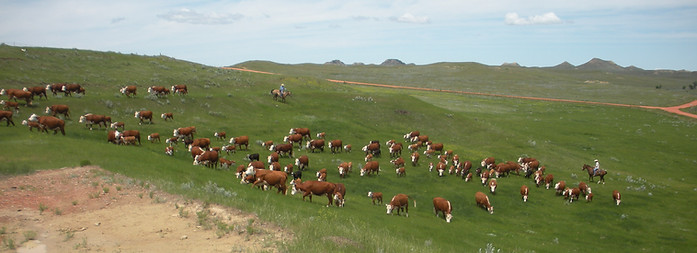PUREBRED REGISTERED HORNED HEREFORD CATTLE
PUREBRED REGISTERED HORNED HEREFORD CATTLE
PUREBRED REGISTERED HORNED HEREFORD CATTLE
SPARKS RANCH
Tom and Carol Sparks raise Horned Hereford cattle on the plains of southeastern Montana. It has been over 100 years since George W. and Bernetta A. Sparks homesteaded south of Plevna, arriving from Oklahoma. Since then, four generations of Sparks' have called the ranch home with some boundary changes through the years. Presently, Tom and Carol and their son and daughter-in-law William and Jimmie, operate the ranch on a daily basis. Tom and Carol's other three children - Frank A., Katy, and George - also help with ranch work, some more than others. Tom's father, Frank, passed away in 1999 and Goldie, Tom's mother, passed away in 2018. It was Frank and Goldie who began the registered Hereford breeding program in 1956.
Sparks Herefords breeds cattle generally unrelated to other in the industry. They use mostly their own bulls, with some outside bulls purchased and AI incorporated. There has been intense line-breeding, some inbreeding (where genetics manifest themselves quickly), and some outcrosses. Line 1 out of Fort Keogh in Miles City has had a big influence in the herd genetics, but also a line of Herefords from England, Tarrington, have been used extensively. In 1966 Frank Sparks purchased one of two Tarrington bred females imported from England to North America. Since then several more pure Tarrington or English females were added. Frank purchased the bull "Wenlock Tarzon" at the Regina Hereford Centennial Sale to head up the Sparks' Tarrington line of cattle. The Tarringtons are excellent mothers, good milkers and easy keepers, necessary in the extreme environment of eastern Montana.
The Prospector line of Herefords has been the most inbred throughout the years, some as much as 46%. It is a line of cattle began as a study at Colorado Experiment Station in 1947. The Prospector line kept improving in performance, reproduction, milking ability and exhibited a lot of color pigmentation around the eyes. Today this line is used as an outcross and is related to very few Hereford cattle in the US.

Other lines that you will see in the Sparks pedigrees include Tiberius and some outcross lines from other herds as bulls were purchased and introduced. Calving takes place in April and early May; weaning happens in October. Cows and calves are strictly grazing machines with no supplemental feed other than salt and mineral. All heifer calves are retained through the winter; culling happens in the spring before the replacement heifers go to breeding pastures. Bull calves are wintered on 40 acres, coming to the barn for their morning ration of feed with a protein supplement. Their gain is tested over a 120 day period. Sale bulls are semen tested in early-mid May and put on grass for their yearling summer. Over their yearling-to-2-year-old winter, the sale bulls get a daily feeding of hay and some alfalfa pellets. Excellent records are kept on the whole herd, include actual birth weights, weaning weights, gain indexes, and, of course, pedigrees. No growth hormones are used; whole herd vaccinations follow industry standards.
Please enjoy viewing the "Beyond Cowpies" page on this site. Tom and Carol feel lucky that all of their children have a love of and respect for the agriculture way of life. Consequently, they have found ways to stayed involved with the ranch and this page reflects the multiple interests of the family.
Thank you for reading about our ranch. You are cordially invited to stop at the ranch to visit and view cattle. There may even be cookies in the cookie jar!
